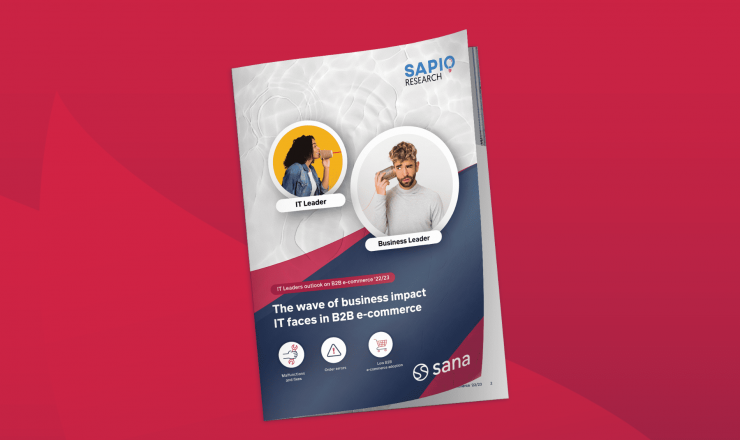

In today’s rapidly evolving business environment, B2B businesses and enterprises are seeking innovative solutions to stay competitive and meet customer demands. Composable commerce is one of those solutions that has caught the attention of B2B companies.
In this blog, we will explore what composable commerce is, how it relates to MACH architecture, and how you can use it to put your B2B business ahead of the curve.
What is composable commerce?
Composable commerce is a development approach of selecting best-of-breed e-commerce components and putting them together into a custom application built for specific B2B business needs. Composable commerce is closely aligned with the MACH architecture (Microservices, API-First, Cloud-Native, and Headless) and offers a transformative approach to B2B e-commerce.
Composable commerce architecture allows B2B businesses flexibility and customization that allows them to get the best of each of the software products they use. These individual software products are often referred to as Packaged Business Capabilities or PBCs.
What is MACH architecture and how does it relate to composable commerce?
Composable commerce shares a strong correlation with the principles of MACH architecture. MACH architecture, comprising of Microservices, API-first, Cloud-native, and Headless components, represents the ideal vision for composable commerce.
Here’s a breakdown of each of those aspects:
Microservices
Microservices are a way in which an application is or can be broken down by functionality into independent services. Packaged Business Capabilities (PBCs) are an aggregated set of microservices. By using these tools, this flexibility allows businesses to deploy capabilities independently and fosters agility and scalability.
API-first
By exposing all functionalities through APIs, composable commerce enables the seamless integration of multiple applications or services. This API-centric approach empowers B2B businesses to adopt a composable approach to e-commerce development, connecting various components efficiently.
Cloud-native
Embracing cloud-native infrastructure ensures scalability, flexibility, and on-demand access to different parts of the application. Leveraging cloud capabilities eliminates the need for traditional upgrades and optimizes resource allocation.
Headless
Headless applications, known for their decoupled front-end and back-end services, allow continuous improvement of the customer interface. With headless architecture, businesses can extend their applications to various endpoints, including connected devices, enhancing the overall customer experience.
The benefits of composable commerce for B2B sellers
- Modular and flexible: Composable commerce offers B2B businesses modular deployment of independent PBCs, allowing businesses to add, replace, or remove functionalities as their needs evolve. This modularity eliminates risks associated with tightly coupled services and provides the flexibility to adapt the application over time.
- Open and easy integration: Composable commerce is built on open standards and integration patterns, facilitating seamless integration with existing systems and best-of-breed PBCs and microservices. The open nature of composable commerce encourages easy customization and extensibility, enabling businesses to tailor the application to their specific requirements.
- Scalable and adaptive: Composable commerce empowers B2B enterprises to scale their e-commerce operations efficiently. By leveraging cloud-native infrastructure, businesses can leverage the scalability and flexibility of cloud services, ensuring the application can handle varying workloads and adapt to market demands.
- Business-focused and cost-efficient: Composable commerce provides B2B businesses with the necessary tools and capabilities for both business buyers and development teams. This business-focused approach allows organizations to have full control over the iteration and innovation process while reducing costs and risks associated with traditional monolithic platforms.
- Enhanced customer experience: With composable commerce, businesses can leverage best-of-breed components, from content management to payment processing, seamlessly combining them to create superior e-commerce experiences. The flexibility of composable commerce enables businesses to deliver personalized and tailored experiences to their customers, ultimately boosting customer satisfaction and loyalty.
- Future-proof and agile: Composable commerce equips B2B enterprises with a future-proof foundation to adapt to emerging technologies and market trends. The modular and composable nature of the architecture allows businesses to integrate new services seamlessly, ensuring they stay ahead of the curve and can quickly respond to changing customer needs.
How does ERP-integrated e-commerce fit in a composable commerce approach?
ERP-integrated e-commerce is the natural extension upon which the composable commerce approach is founded. ERP e-commerce integration is the process of connecting an e-commerce platform with an ERP (enterprise resource planning) system. This allows for a better flow of data and synchronization between the two systems, improving accuracy and minimizing siloes in the process.
You can see how this naturally fits into the philosophy behind composable commerce. It synthesizes the best functionalities of each piece of software and creates a super-powered solution that works best for the B2B business using it.
It’s important that these solutions be truly integrated with one another with real-time syncing. Imagine it as a series of traffic signals in a city that should all communicate with one another. If they aren’t connected in real time then you increase the likelihood of traffic jams, errors and disruptions. It’s the same with the PBCs you include in your composable commerce architecture. The only way you increase your business efficiency is if your back office systems, like your ERP and e-commerce, are natively integrated with one another.
How composable commerce helped PALFINGER drive online results
When PALFINGER was in the market for a new e-commerce solution, flexibility was key to achieving what they wanted. They needed something that integrated seamlessly within their existing tech infrastructure, while powering the automation necessary to meet their targets.
PALFINGER’s Vision & Strategy 2030 is based on two strategic pillars, “Go for Solutions” and “Go Digital.” The former aims at PALFINGER offering integrated complete solutions, while the latter focuses on practically leveraging the potential of digitalization. Or, in a nutshell, their vision is aligned with the principles of composable commerce.
Regarding their choice of Sana Commerce as the perfect B2B e-commerce solution to fit inside this vision, PALFINGER’s e-commerce manager, Ramböck Florentine said,
“In the past, we offered a spare part ordering tool based on material numbers. Now, with Sana Commerce, we offer more information; images, a navigation system, and the full order history.”
Putting it all together with composable commerce
By adopting a composable commerce strategy, B2B businesses can harness the power of modular deployment, easy integration, scalability, and a customer-centric approach. The flexibility provided by composable commerce allows businesses to select and develop only the features and functionalities necessary for their unique requirements, resulting in leaner and faster applications.
Moreover, composable commerce empowers businesses to seamlessly combine best-of-breed components, such as content management and payment processing, to deliver superior customer experiences across channels. This customer-centric approach is vital as customer demands continue to evolve rapidly.
Additionally, composable commerce ensures that B2B enterprises have greater control over their e-commerce application delivery. The decoupled nature of the architecture enables businesses to manage e-commerce experiences across various channels effectively. By setting themselves up for success with a future-proof application, companies can navigate digital transformation with ease.




